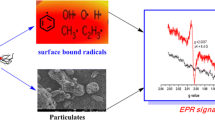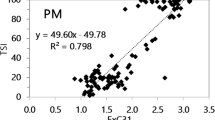Abstract
Fractionation data for cadmium in tobacco products, as obtained by sequential leaching of cadmium species with ICP-MS/MS analysis, and separately by X-ray absorption near edge structure (XANES) are presented here for the first time. The total amount of cadmium found in 3R4F cigarette cut tobacco was 1526 ± 42 μg kg−1, of which 5% was found in the smoke under ISO smoking conditions. XANES analysis showed that Cd in tobacco, cigarette smoke and ash was present in the + 2 oxidation state. Examination of the gas-particle partitioning of smoke cadmium suggests that Cd in mainstream smoke is best viewed as semi-volatile, existing in both particulate and gas phases. Sequential extraction of trapped tobacco smoke was carried out to get a deeper insight into the chemistry of cigarette smoke cadmium compounds. Consecutive extractions with ultrapure water, dilute (1%) nitric acid and 10% nitric acid led to extraction of a total amount of Cd which agreed with that obtained after microwave digestion of the whole sample, suggesting that cadmium was quantitatively leachable into aqueous/acidic solutions. Most Cd (~ 90% of the total Cd in the smoke condensate) was extracted into dilute nitric acid (likely as CdO, Cd(OH)2 and CdCO3) with a minor percentage (3%) extracted into water (likely as CdCl2) and in 10% nitric acid (likely as CdS). Extraction of trapped mainstream smoke with pentane, followed by ICP-MS/MS analysis, to examine the possible presence of organocadmium in 3R4F tobacco smoke, did not show the presence of organocadmium compounds above the method LOQ (2 μg kg−1), possibly due to their reactivity under the experimental conditions. The high selectivity with sufficient sensitivity achieved by ICP-MS/MS was invaluable to quantify Cd (at low μg kg−1levels) simultaneously with sulphur and chlorine in the tobacco smoke fractions of complex matrix. The cadmium chemistry in the smoke, identified in this study, is consistent with both relatively high lung absorption and DNA binding; both potentially important factors for disease progression in smokers.

This paper provides quantitative fractionation data for cadmium in tobacco and smoke by using sequential leaching with ICPMS and XANES






Similar content being viewed by others
References
Tsadilas CD, Karaivazoglou NA, Tsotsolis NC, Stamatiadis S, Samaras V. Cadmium uptake by tobacco as affected by liming, N form, and year of cultivation. Environ Pollut. 2005;134:239–46.
Tsadilas CD. Soil pH influence on cadmium uptake by tobacco in high cadmium exposure. J Plant Nutr. 2000;23:1167–78.
Food and Drug Administration. Harmful and potentially harmful constituents in tobacco products and tobacco smoke: established list. 2012. Available at:https://www.fda.gov/TobaccoProducts/GuidanceComplianceRegulatoryInformation/ucm29778. Accessed 21 March 2018.
Cuello S, Entwisle J, Benning J, Liu C, Coburn S, McAdam KG, et al. Complementary HPLC-ICP-MS and synchrotron X-ray absorption spectroscopy for speciation analysis of chromium in tobacco samples. J Anal At Spectrom. 2016;31:1818–29.
Taebunpakul S, Liu C, Wright C, McAdam K, Heroult J, Braybrook J, et al. Determination of total arsenic and arsenic speciation in tobacco products: from tobacco leaf and cigarette smoke. J Anal At Spectrom. 2011;26:1633–40.
Stephens WE, Calder A, Newton J. Source and health implications of high toxic metal concentrations in illicit tobacco products. Environ Sci Technol. 2005;39:479–88.
Piade JJ, Jaccard G, Dolka C, Belushkin M, Wajrock S. Differences in cadmium transfer from tobacco to cigarette smoke, compared to arsenic or lead. Toxicol Rep. 2015;2:12–26.
Pappas RS, Polzin GM, Zhang L, Watson CH, Paschal DC, Ashley DL. Cadmium, lead, and thallium in mainstream tobacco smoke particulate. Food Chem Toxicol. 2006;44:714–23.
Kalcher K, Kern W, Piestch R. Cadmium and lead in the smoke of a filter cigarette. Sci Total Environ. 1993;128:21–35.
Csalari J, Szantai K. Transfer rate of cadmium, lead, zinc and iron from the tobacco-cut of the most popular Hungarian cigarette brands to the combustion products. Acta Aliment Hung. 2002;31:279–88.
Gondola I, Kadar I. Heavy metal content of flue-cured tobacco leaf in different growing regions of Hungary. Acta Agron Hung. 1993;43:243–51.
Rodgman A, Perfetti TA. The chemical components of tobacco and tobacco smoke. 2nd ed: Taylor and Francis Group; 2013.
Cadmium and cadmium compounds. Available at: https://monographs.iarc.fr/ENG/Monographs/vol100C/mono100C-8.pdf. Accessed 20 June 2018.
Development support document for cadmium and cadmium compounds. Texas Commission on Environmental Quality (TCEQ). 2016. Available at: http://www.tceq.texas.gov/assets/public/implementation/tox/dsd/final/cadmium.pdf. Accessed 26 March 2018.
Adam V, Fabrik I, Eckschlager T, Stiborova M, Trnkova L, Kizek R. Vertebrate metallothioneins as target molecules for analytical techniques. Trends Anal Chem. 2010;29:409–18.
Pappas RS, Fresquez MR, Watson CH. Cigarette smoke cadmium breakthrough from traditional filters: implications for exposure. J Anal Toxicol. 2015;39:45–51.
Wartman WB, Cogbill EC, Harlow ES. Determination of particulate matter in concentrated aerosols. application to analysis of cigarette smoke. Anal Chem. 1959;31:1705–9.
Tolman RC, Reyerson LH, Brooks AP, Smyth DH. An electrical precipitator for analysing smokes. J Am Chem Soc. 1919;41:587–9.
Kapp R, Smoke T. In: Wexler P, Anderson BD, Peyster A, Gad SC, Hakkinen PJ, Kamrin MA, Locey BJ, Mehendale HM, Pope CN, Shugart LR, editors. Enclyclopedia of toxicology. 2nd ed: Elsevier; 2005. p. 200–2.
Baker RR, Chemistry S. In: Davis DL, Nielsen MT, editors. Tobacco production, chemistry and technology: Blackwell Science Ltd; 1999. p. 398–439.
John E, Coburn S, Liu C, McAughey J, Mariner D, McAdam KG, et al. Effect of temperature and humidity on the gas–particle partitioning of nicotine in mainstream cigarette smoke: a diffusion denuder study. J Aerosol Sci. 2018;117:100–17.
Williamson JT, Graham JF, Allman DR. The modification of cigarette smoke by filter tips. Beitr Tabakforsch. 1965;3:233–42.
Grob K. Gas chromatography of cigarette smoke. Part III. Separation of the overlap region of gas and particulate phase by capillary columns. J Gas Chrom. 1965;3:52–65.
Klus H, Boenke-Nimphius B, Muller L. Cigarette mainstream smoke: the evolution of method and devices for generation, exposure and collection. Beitr Tabakforsch. 2016;27:137–274.
Pacyna JM. Atmospheric emissions of arsenic, cadmium, lead and mercury from high temperature processes in power generation and industry. In: Hutchinson TC, Meema KM, editors. Lead, mercury, cadmium and arsenic in the environment: John Wiley & Sons Ltd; 1987. p. 69–87.
Breitinger DK. Cadmium and its inorganic compounds. In: Hermann WA, editor. Synthetic methods of organometallic and inorganic chemistry: Thieme; 1999. p. 167–81.
Roemer E, Schramke H, Weiler H, Buettner A, Kausche S, Weber S, et al. Mainstream smoke chemistry and in vitro and in vivo toxicity of the reference cigarettes 3R4F and 2R4F. Beitr Tabakforsch. 2012;25:316–35.
Liu C, Hu J, McAdam KG. A feasibility study on oxidation state of arsenic in cut tobacco, mainstream cigarette smoke and cigarette ash by X-ray absorption spectroscopy. Spectrochim Acta B. 2009;64:1294–301.
Borgerding M, Klus H. Analysis of complex mixtures—cigarette smoke. Exp Toxicol Pathol. 2005;57:43–73.
Ciftci H, Olcucu A. Determination of iron, copper, cadmium and zinc in some cigarette brands in Turkey. Int J Sci Technol. 2007;2:29–32.
IMEP-114: Determination of total Cd, Pb, As, Hg and Sn in feed premixes. Available at: http://publications.jrc.ec.europa.eu/repository/bitstream/JRC78163/jrc78163_imep-114%20full%20report.pdf. Accessed 20 June 2018.
Rodgman A, Perfetti TA. In: Rodgman A, Perfetti TA, editors. In the chemical components of tobacco and tobacco smoke. Boca Raton: Taylor and Francis Group, CRC Press; 2009.
Murphy KE, Vetter TW. Recognizing and overcoming analytical error in the use of ICP-MS for determination of cadmium in breakfast cereal and dietary supplements. Anal Bioanal Chem. 2013;405:4579–88.
Ravel B, Newville M. ATHENA, ARTEMIS, HEPHAESTUS: data analysis for X-ray absorption spectroscopy using IFEFFIT. J Synchrotron Radiat. 2005;12(4):537–41.
Ravel B. IFEFFIT: interactive XAFS analysis and FEFF fitting. J Synchrotron Radiat. 2001;8:322–4.
Roemer E, Schramke H, Weiler H, Buettner A, Kausche S, Weber S, et al. Mainstream smoke chemistry and in vitro and in vivotoxicity of the reference cigarettes 3R4F and 2R4F. Beitr Tabakforsch Int. 2012;25:316–35.
Kuroki Y, Yokohama S, Takahashi H, Fujiwara M. Development of an analytical method for the simultaneous determination of trace metals and mercury in mainstream cigarette smoke by ICP-MS. 63rd Tobacco Science Research Conference 2009;63:49–50.
Eldridge A, Betson TR, Gama M, McAdam K. Variation in tobacco and mainstream smoke toxicant yields from selected commercial cigarette products. Regul Toxicol Pharmacol. 2015;71:409–27.
Piade JJ, Wajrock S, Jaccard G, Janeke G. Formation of mainstream cigarette smoke constituents prioritized by the World Health Organization–yield patterns observed in market surveys, clustering and inverse correlations. Food Chem Toxicol. 2013;55:329–47.
Nitsch A, Kalcher K, Greschonig H, Pietsch R. Schwermetalle in Tabaken und in Tabakrauchll: Spurenelemente Cadmium, Blei, Kupfer, Kobalt und Nickel in oesterreichischenZigaretten und derenRauchkondensaten und Rauchgasen. Beitr Tabakforsch Int. 1991;15:19–32.
Wu D, Landsberger S, Larson SM. Determination of the elemental distribution in cigarette components and smoke by instrumental neutron activation analysis. J Radioanal Nucl Chem. 1997;217:77–82.
Xue L, Thomas CE, Koller KB. Mainstream smoke gas phase filtration performance of adsorption materials evaluated with a puff-by-puff multiplex GC-MS method. Beitr Tabakforsch Int. 2002;20:251–6.
Branton P, Lu A-H, Schüth F. The effect of carbon pore structure on the adsorption of cigarette smoke vapour phase compounds. Carbon. 2009;47:1005–11.
Alderman SL, Song C, Moldoveanu SC, Cole SK. Particle size distribution of e-cigarette aerosols and the relationship to Cambridge filter pad collection efficiency. Beitr Tabakforsch Int. 2014;26:183–90.
Techniques for the analysis of organic chemicals by inductively coupled plasma mass spectrometry (ICP-MS) Agilent Technologies Applications 5988-6190EN. Available at: http://www.youngin.com/application/AN-0809-0095EN.pdf. Accessed 26 March 2018.
Schmeltz I, Tosk J, Jacobs G, Hoffmann D. Redox potential and quinone content of cigarette smoke. Anal Chem. 1977;49:1924–9.
Wooten JB. Gas-phase radicals in cigarette smoke: a re-evaluation of the steady-state model and the Cambridge filter pad. Mini-Rev Org Chem. 2011;8:412–26.
Author information
Authors and Affiliations
Corresponding author
Ethics declarations
Conflict of interest
The authors declare that they have no conflict of interest.
Electronic supplementary material
ESM 1
(PDF 198 kb)
Rights and permissions
About this article
Cite this article
Cuello-Nuñez, S., Benning, J., Liu, C. et al. Fractionation of cadmium in tobacco and cigarette smoke condensate using XANES and sequential leaching with ICP-MS/MS. Anal Bioanal Chem 410, 6795–6806 (2018). https://doi.org/10.1007/s00216-018-1265-6
Received:
Revised:
Accepted:
Published:
Issue Date:
DOI: https://doi.org/10.1007/s00216-018-1265-6




